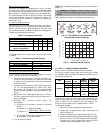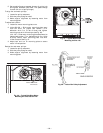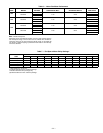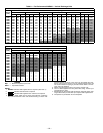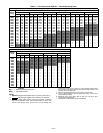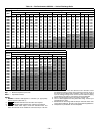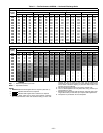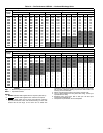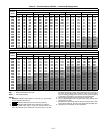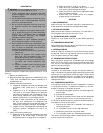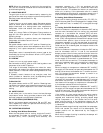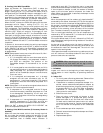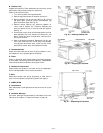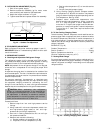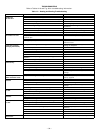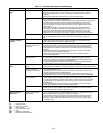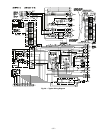
—
28
—
PRE-START-UP
Proceed as follows to inspect and prepare the unit for initial
start-up:
1. Remove all access panels.
2. Read and follow instructions on all WARNING, CAU-
TION, and INFORMATION labels attached to or
shipped with unit.
3. Make the following inspections:
a. Inspect for shipping and handling damages such
as broken lines, loose parts, or disconnected
wires.
b. Inspect for oil at all refrigerant tubing connec-
tions and on unit base. Detecting oil generally
indicates a refrigerant leak. Leak-test all refrig-
erant tubing connections using electronic leak
detector, halide torch, or liquid-soap solution.
c. Inspect all field- and factory-wiring connections.
Be sure that connections are completed and
tight. Ensure electrical wiring does not come into
contact with refrigerant tubing or sharp edges.
d. Inspect coil fins. If damaged during shipping and
handling, carefully straighten fins with a fin
comb.
4. Verify the following conditions:
a. Make sure that outdoor-fan blades are correctly
positioned in fan orifice. Refer to Outdoor Fan
Adjustment section on page 32 for more details.
b. Make sure that air filter(s) is in place.
c. Make sure that condensate drain trap is filled
with water to ensure proper drainage.
d. Make sure that all tools and miscellaneous loose
parts have been removed.
e. Ensure belt and blower pulley are properly
aligned and at correct tension.
START-UP
I. UNIT PREPARATION
Make sure that unit has been installed in accordance with
these installation instructions and applicable codes.
II. RETURN AIR FILTERS
Make sure correct filters are installed in unit (see Table 1).
Do not operate unit without return-air filters.
III. OUTDOOR-AIR INLET SCREEN
Outdoor-air inlet screen must be in place before operating
unit.
IV. COMPRESSOR MOUNTING
Compressors are internally spring mounted. Do not loosen or
remove compressor holddown bolts.
V. INTERNAL WIRING
Check all electrical connections in unit control boxes; tighten
as required. Ensure wiring does not come into direct contact
with refrigerant tubing or sharp edges.
VI. REFRIGERANT SERVICE PORTS
Each refrigerant system has 4 Schrader-type service gage
ports: One on the suction line, one on the cooling mode liquid
line, and 2 on the compressor discharge line. Be sure that
caps on the ports are tight.
VII. HIGH FLOW VALVES
Located on the compressor hot gas and suction tubes are
High Flow Valves. Large black plastic caps distinguish these
valves with O-rings located inside the caps. These valves
cannot be accessed for service in the field. Ensure the plastic
caps are in place and tight or the possibility of refrigerant
leakage could occur.
VIII. COMPRESSOR ROTATION
It is important to be certain the scroll compressor is rotating
in the proper direction. To determine whether or not com-
pressor is rotating in the proper direction:
1. Connect service gages to suction and discharge pres-
sure fittings.
2. Energize the compressor.
3. The suction pressure should drop and the discharge
pressure should rise, as is normal on any start-up.
If the suction pressure does not drop and the discharge pres-
sure does not rise to normal levels:
1. Note that the indoor fan is probably also rotating in
the wrong direction.
2. Turn off power to the unit and tag disconnect.
3. Reverse any two of the unit power leads.
4. Turn on power to the unit. Reenergize compressor.
The suction and discharge pressure levels should now move
to their normal start-up levels.
WARNING: Failure to observe the following warn-
ings could result in serious personal injury:
1. Follow recognized safety practices and wear
protective goggles when checking or servicing
refrigerant system.
2. Do not operate compressor or provide any elec-
tric power to unit unless compressor terminal
cover is in place and secured.
3. Do not remove compressor terminal cover until
all electrical sources are disconnected and
tagged.
4. Relieve all pressure from system before touch-
ing or disturbing anything inside compressor
terminal box if refrigerant leak is suspected
around compressor terminals. Use accepted
methods to recover refrigerant.
5. Never attempt to repair soldered connection
while refrigerant system is under pressure.
6. Do not use torch to remove any component. Sys-
tem contains oil and refrigerant under pres-
sure. To remove a component, wear protective
goggles and proceed as follows:
a. Shut off electrical power to unit and install
lockout tag.
b. Relieve all pressure from system using
both high- and low-pressure ports. Use
accepted methods to recover refrigerant.
c. Cut component connection tubing with tub-
ing cutter and remove component from
unit.
d. Carefully unsweat remaining tubing stubs
when necessary. Oil can ignite when
exposed to torch flame.



